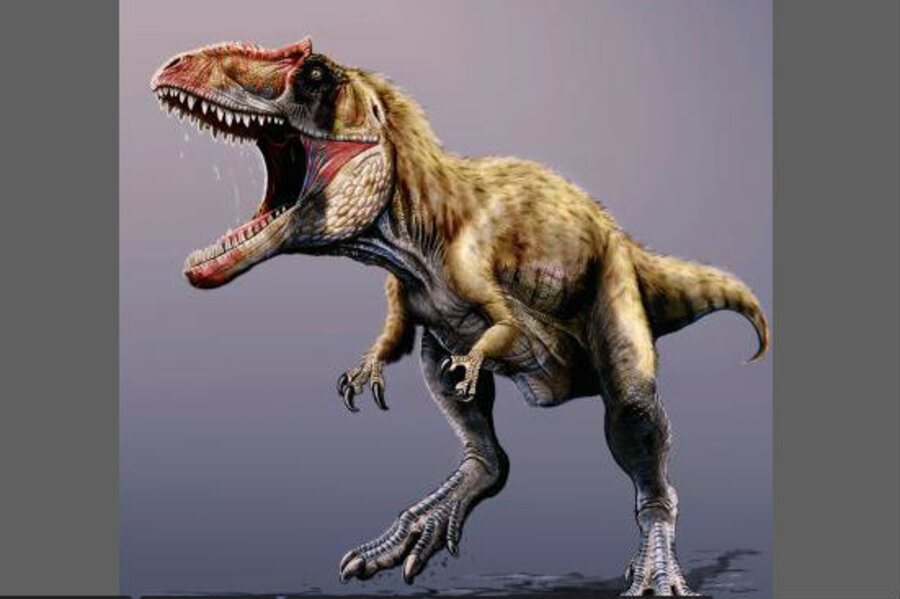Here's a dinosaur that scared even the tyrannosaurs
Loading...
Paleontologists report this week in Nature Communications the find of a new gigantic, carnivorous dinosaur species that is believed to have for millions of years kept tyrannosaurs from evolving into T. rex, the mightiest of all tyrant lizards. Not until this new dinosaur – called Siats, after the cannibalistic and man-eating monsters from Utah’s Ute tribe legends – disappeared from the planet could T. rex ascend to its ecosystem’s throne.
“Siats is a giant,” says Lindsay Zanno, lead author on the paper and director of Paleontology at the North Carolina Museum of Natural Sciences. “Tyrannosaurs were living in the shadows.”
Siats – full name, Siats meekerorum – was about 30 feet long. It weighed about 4 tons. And that’s just the size of a juvenile Siats; the hind limb, pelvis, and backbone that the paleontologists found, in Utah’s Cedar Mountain Formation in 2008, is from a not yet full-grown dinosaur. It’s possible that, at adult-size, Siats is the second largest carnivorous dinosaur ever known to roam North America, says Dr. Zanno. The largest is T. rex, which weighed twice as much as Siats and appeared not until 30 million or so years later.
And it took 30 million years because, so long as Siats was around, there was little chance of T. rex’s bantam ancestors evolving into something big and strong, says Zanno. Siats is a carcharodontosaur, a group of humongous carnivores that had wielded their size over just about everything in their ecosystems all around the world during the late Jurassic period. Later, when the carcharodontosaurs vanished, the tyrannosaurs, which include T. rex, emerged to preside over their terrorized territories.
Tyrannosaurs and carcharodontosaurs look similar: big bodies, big teeth, big skulls, and two legs. Carcharodontosaurs, though, have more slender skulls and more substantial arms than do tyrannosaurs. Tyrannosaurs are also more related to birds than are carcharodontosaurs.
In North America, the dynastic changing of the guard from carcharodontosaurs to tyrannosaurs had presented a problem. The fossil record had shown that the only other carcharodontosaur (before Siats) ever found in North America, Acrocanthosaurus, had disappeared about 110 million years ago. Not until about 65 million years ago did T. rex, the last and most terrible predator in a long line of tyrannosaurs, control North America.
These numbers had not quite added up. If carcharodontosaurs had ended in North America with the Acrocanthosaurus some 110 million years ago, and tyrannosaurs had picked up the crown 65 million years ago, what had happened in the intermediate period? What dinosaur had been the mightiest dinosaur of them all? Had tyrannosaurs perhaps grown big and strong earlier than thought? Or had carcharodontosaurs held on for longer than paleontologists had known?
Siats, at some 98 million years old, presents a partial answer to that problem. At that time, it would have succeeded Acrocanthosaurus as North America's apex predator. With something so big as Siats's stomping around, the tyrannosaurs had no chance at evolving into T. rex. In the same rock beds that hold Siats’ big bones, the paleontologists also found teeth from diminutive tyrannosaurs no bigger than a large dog – tyrannosaurs not at all like the massive T. rex that would control swaths of the Earth some 20 million years later.
“It wasn't until carcharodontosaurs vacated these top predator roles in North America that tyrannosaurs were free to evolve into the giant predators we know and love today,” says Zanno.
But what did, in fact, happen to Siats? Well, paleontologists don’t yet know. One clue is that sauropod (long-neck) dinosaurs went extinct at about the same time as did Siats. It could be that a break in the food chain’s lowest links plowed the sauropods off Earth, which in turn killed their hunters, Siats, says Zanno.
Still, even the addition of Siats to the succession of dinosaur rulers leaves a gap in paleontologists’ predator portrait of North America, says Zanno. That’s because the first, truly terrifying tyrannosaur that could have presided over North America does not appear in the fossil record until 80 million years ago. The existence of that dinosaur, Lythronax, or “the king of gore,” was announced just this month.
“There is still a 20 million year gap before we see the first definitive large-bodied tyrannosaurs,” says Zanno. The question now is: when did tyrannosaurs actually ascend to top predator roles? And what happened to the giant carcharodontosaurs of the Late Cretaceous?”






